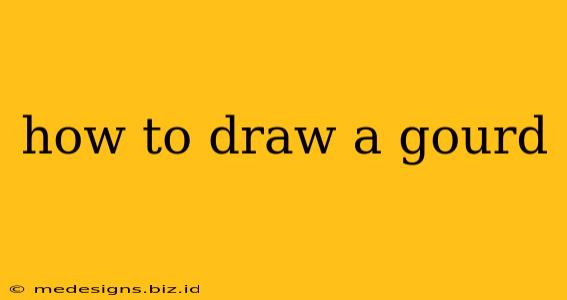Drawing a gourd might seem daunting, but with a few simple steps, you can create a realistic and charming depiction of this versatile fruit. This guide will walk you through the process, perfect for artists of all skill levels, from beginners picking up a pencil for the first time to those looking to refine their botanical drawing techniques. We'll cover various gourd shapes and styles, ensuring you can capture the essence of this fascinating plant.
Understanding Gourd Shapes and Forms
Before we begin, let's appreciate the diversity of gourds. They come in various shapes and sizes – long and slender, round and plump, bumpy or smooth. Understanding these variations will help you create a more believable drawing. Some common gourd shapes include:
- Bottle Gourds: These are characterized by their long, slender necks and bulbous bodies.
- Calabashes: Often round or oval, calabashes are known for their hard shells.
- Lagenarias: This diverse group includes many shapes and sizes, from small and delicate to large and imposing.
Observing real gourds, photos, or even using a gourd as a model will significantly improve your drawing accuracy.
Materials You Will Need
Gather your art supplies. You'll need:
- Pencil: A standard HB or 2B pencil is ideal for sketching.
- Eraser: A good eraser is essential for correcting mistakes.
- Paper: Use smooth drawing paper for best results.
- Optional: Colored Pencils, Markers, or Paints: Add color to your gourd drawing to bring it to life!
Step-by-Step Drawing Instructions
Let's draw a classic, round gourd. Follow these steps:
Step 1: The Basic Shape
Start by sketching a slightly elongated oval or circle. This will form the basic shape of your gourd. Don't worry about making it perfect; this is just a guideline.
Step 2: Adding the Stem
Draw a small, curved line at the top of your oval. This will be the stem of the gourd. Experiment with the stem's thickness and curvature.
Step 3: Refining the Shape
Now, carefully refine the shape of your gourd. Add subtle curves and bulges to make it look more realistic and less like a perfect geometric form. Gourds are rarely perfectly symmetrical.
Step 4: Adding Details (Optional)
Depending on the type of gourd you are drawing, you might add details such as:
- Texture: Lightly sketch in subtle bumps or ridges to suggest the texture of the gourd's skin.
- Highlight and Shadow: Add shading to create dimension and depth. Observe where the light would naturally hit the gourd and add highlights accordingly. This adds realism.
- Vine: Consider adding a vine or leaves to your drawing to further enhance the botanical setting.
Step 5: Final Touches
Once you're satisfied with your pencil sketch, you can add color using colored pencils, markers, or paints. Experiment with different shading techniques to achieve a realistic look.
Tips for Drawing Different Gourd Types
Remember, the key is observation! Study the specific gourd you are trying to draw and pay attention to its unique characteristics.
- Long, slender gourds: Start with a long, thin oval and gradually curve it to create the desired shape.
- Bumpy gourds: Use short, curved lines to add the bumps and ridges to your basic shape.
- Unusual shapes: Don't be afraid to experiment and try different shapes and forms.
Practice Makes Perfect
Drawing is a skill that improves with practice. The more you draw, the better you will become at capturing the essence of the subject. Don't be discouraged if your first attempts aren't perfect – keep practicing, and you'll soon be drawing beautiful gourds with confidence. Use different references, experiment with shading, and have fun exploring the diverse world of gourds!
